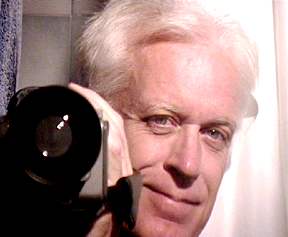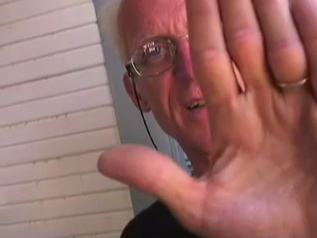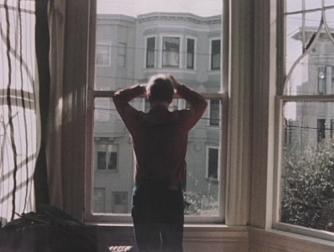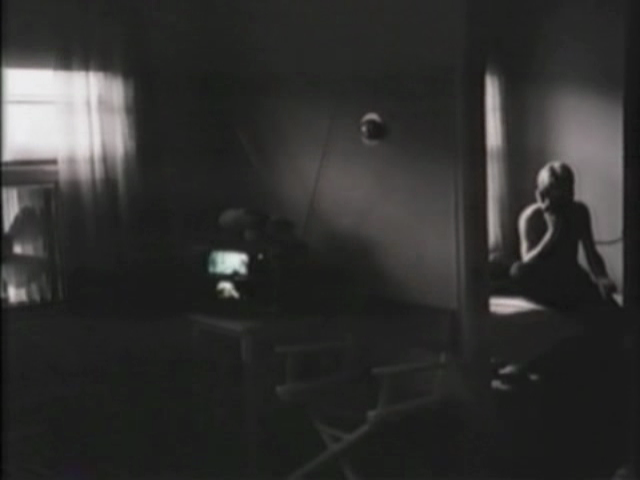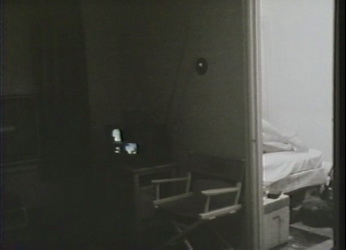From the Chicago Reader (May 8, 1992). — J.R.
JON JOST RETROSPECTIVE
Last week Jon Jost, a Chicago-born independent filmmaker, was having the first commercial run of his career — All the Vermeers in New York, his tenth feature, at the Music Box. Typically, he couldn’t be around for the event because he was busy shooting his 12th feature in Oregon.
The Music Box engagement launches a Jost retrospective that continues at Chicago Filmmakers on weekends for the remainder of this month. It’s the most exciting and important American retrospective to hit town since the Music Box’s John Cassavetes series last fall, though like that series it isn’t quite complete: only about half of Jost’s shorts — most made in the 60s and early 70s — are included, and two of his features, Bell Diamond (1985) and Sure Fire (1990), are omitted. (Sure Fire may open here in the fall if enough people go to see All the Vermeers in New York.) Still, it’s the most comprehensive show of Jost’s work that’s ever come to Chicago, and it offers a great chance to catch up with a singular career that has been more subterranean than most, even among American independents.
Evoking Cassavetes in connection with Jost may be misleading, because in many ways these filmmakers are polar opposites. In contrast to the collective dramas generated by Cassavetes and his actors, most of Jost’s movies are eclectic and caustic one-man shows that are strong in just about every way except drama in the usual sense. It’s interesting to see how Jost has gradually worked his way toward a method of improvisation with his actors that shares a few premises with Cassavetes’s first feature, Shadows — a method most apparent in Rembrandt Laughing (1988) and All the Vermeers in New York (1990), the most populated of his narrative features. But it would be more accurate to say that his work derives from a completely different universe of assumptions.
Born in Chicago in 1943, Jost was raised in a military family that lived in Georgia, Kansas, Japan, Italy, Germany, and Virginia. He started making films after he was expelled from college in 1963, and two years later was imprisoned by the federal government for burning his draft card and refusing to serve in Vietnam, a term that lasted two years and three months. (Ironically, this may have been the longest period since his teens that he lived at a fixed address; when I first met him in 1977 he was living mainly out of his car.) Afterward, he worked with draft resisters and the Chicago Mobilization, and helped found the Chicago branch of a radical film production and distribution group later known as Newsreel. He then moved to the northwest — living mainly in rural sections of Oregon and Montana — where his remarkable early features Speaking Directly (1973) and Last Chants for a Slow Dance (1977) were made. During the same period he lived intermittently in Los Angeles and made two other features there, Angel City (1976) and Chameleon (1978).
This Sunday’s program of some of Jost’s rarely screened early shorts includes two silent films he made shortly before he went to prison, Portrait and City. Unless one imparts significance to a voter-registration poster in the Chicago-made City, neither film can be called political. Judging from what I’ve seen — all of Jost’s features and about half his shorts — this isn’t true of any film Jost has made since his prison stint. For all their stylistic and thematic differences, they’re clearly informed by a political sensibility.
A Newsreel short chronicling a Chicago antiwar demonstration on April 27, 1967 — produced by Peter Kuttner, but edited and briefly narrated by Jost — begins the Sunday program, and offers a cogent sense of what it was like to be alive and political in Chicago a quarter century ago, physically as well as emotionally and spiritually, when the Vietnam war was still raging and Richard Daley’s police force was cracking heads. The purposefulness of Jost’s editing — which cuts between documentary footage and still photographs of the event, and includes offscreen accounts of brutalized demonstrators as well as Jost’s recital of a few facts at the end — introduces the first strong sense of economy that we get in Jost’s work, a notion that is central to his sense of the political. When we come across references to the same demonstration in 13 Fragments & 3 Narratives From Life (1968) and other references to the Vietnam war in Traps (1967), both Chicago-made experimental films, it’s already clear that Jost, unlike most of his American contemporaries who make experimental films, refuses to place his politics and aesthetics in separate compartments.
There’s a certain contradiction, however, between the political thrust of Jost’s early essay films, including Speaking Directly, and the ambiguous and ambivalent ways he uses other people in these works. For the first two decades of Jost’s maverick career it often seems that if it had been up to him, he would have made all his films single-handedly — not only conceived, shot, and edited them, and composed and performed their musical scores, but also recorded the sound and appeared in them alone. (Thoreau’s Walden is an important reference point in Speaking Directly.) This is quite different from the isolation writer-director-actor Jeff Dorchen, for instance, imposes on himself in his brilliant theater piece Birth of a Frenchman (playing at the Curious Theatre Branch), because the social address of live theater is quite different from that of film, and because Dorchen’s punklike appropriations of German expressionism, Belgian surrealism, circus sideshow imagery, and other kinds of shared cultural baggage place his ideas within a discourse that implies some notion of an intellectual community. By contrast, Jost is an intellectual almost entirely without portfolio; that is, his work gives no sense of colleagues, confederates, or communities of artistic discourse — apart from the roles played by the artists cited in the titles of All the Vermeers in New York and Rembrandt Laughing and by Jean-Luc Godard in Godard 80.
A few young women and men speak at length about themselves in some of Jost’s early works, but their appearances usually only emphasize Jost’s isolation, from them as well as from us. That they’re there for Jost’s purposes rather than their own (or ours, for that matter) is usually clear from the outset, yet the liveliest moments of their appearances tend to be when they rebel against their assigned roles and the films themselves.
Jost’s isolation from his family is made clear by the following brief speech in Speaking Directly, which we hear while looking at a family snapshot: “My parents: I’m just getting to know them after not seeing them for about eight or ten years. My father is a retired Army colonel whom I think of as a war criminal, and my mother, as a cipher, shielded herself from the world with the apology that she is a woman and therefore not responsible.” His isolation from the viewer during this period in his career is equally pronounced, both because of and in spite of the rigorous honesty and thoroughness of his self-analysis; yet Speaking Directly, which is subtitled Some American Notes, conveys much more to me of the taste, thought, and passion of 60s counterculture than anything I’ve seen about that era in the mainstream media (a bracing alternative to the endless lies of TV). And Jost is intellectually honest enough to insist on his interconnectedness with both his audience and the rest of the world in spite of his isolation. Consider the following two monologues:
“This is a movie, a way to speak. It is bound, like all systems of communication, with conventions. Some of these are arbitrarily imposed, some are imposed by economic or political pressures, some are imposed by the medium itself. Some of these conventions are necessary: they are the communality through which we are able to speak with one another in this way. But some of these conventions are unnecessary, and not only that, they are damaging to us, they are self-destructive. Yet we are in a bad place to see this. We are in a theater.”
Over a shot of the camera and sound equipment used in the film: “This picture does not show the reality of the things that are here. Such a picture would need to show the world: the iron-ore pits of Minnesota; the steel mills of Gary, Indiana; the gold mines of South Africa; a camera factory in France — to mention just a few things.”
Jost’s strong sense of economy is clear not only from the ridiculously small budgets of his early features — Speaking Directly cost about $2,500, Last Chants for a Slow Dance cost $3,000 — but also from the degree to which these stringent budgets determine the forms and contents of the films. In Last Chants –his first fiction feature, which draws on Jost’s prison experience to give us a creepy road movie about a truly alienated and embittered misogynist loner (Tom Blair)–this is a matter not only of the original country-western songs (written and performed by Jost himself) but also of the radical conceptions of two extremely long takes that together make up almost a third of the film’s 90 minutes. The first of these is a black-and-white shot set at a roadside cafe counter with a red neon sign hovering in the background (though it appears to be in the foreground) — an eerie visual effect that was widely praised as innovative when it turned up last year at Cannes in an award-winning Eurotrash art feature by someone else (soon to be released in this country as Zentropa). The second of these shots, also mainly in black and white, condenses a dozen hours between night and dawn in a small apartment into the same 14 minutes it takes to watch a segment from The Tonight Show, playing in color on a TV in the living room.
Each of these extended takes — like many others in this masterpiece — plays out some awful aspect of the hero’s personality and life to the point that it yields something beyond the usual understanding that fiction offers us about such people. Indeed, by the end of the movie we have learned even more about the “motiveless” killer than either Capote’s In Cold Blood or Mailer’s The Executioner’s Song can teach us –something terrible and pervasive about American life at its loneliest.
If the extraordinary experience of the second shot offers a close parallel to some of the key “structural” films made by U.S. and Canadian independents during the 60s and 70s, Jost’s isolation from the film community during those years virtually guaranteed that he would arrive at such concepts and techniques chiefly on his own. This lonely stance represents both the strength and weakness of his early work — an irreducible kind of self-reliance that usually means a need to reinvent (or else invent ahead of others) certain staples of avant-garde filmmaking. (This is a trait shared by David Lynch in his precommercial days, though the political and historical innocence of Lynch couldn’t be further from the self-definitions of Jost. It’s just that both of them owed part of their originality and freshness to their studied ignorance of what other independent filmmakers were doing.)
If Jost can be said to have any mentor at all, it would be Jean-Luc Godard, who supported his work in the early 70s with the statement, “He is not a traitor to the movies, like almost all American directors. He makes them move.” A few European critics such as Peter Wollen have referred to Jost as “the American Godard,” and while none of his work qualifies as strictly imitative — except for Godard 80, a 17-minute interview that deliberately apes Godardian techniques (to be shown with Angel City on Friday, May 15) — this provides a useful clue about some of the most salient virtues of Jost’s work: lyricism, sharp political and social criticism inflected by polemics, intellectual cogency informed by philosophical concerns, a sense of abstraction in relation to narrative (including many strategies for distancing the viewer from his plots), stylistic eclecticism, a strong and visible interest in painting and music, and a very formal sense of film construction. One also might compare his most noticeable limitations — an occasional hermeticism and a recurring compulsion to end his films with the gratuitous or absurdist deaths of his heroes (Slow Moves, Rembrandt Laughing, and All the Vermeers in New York) — with those of Godard.
Roughly speaking, Jost’s features come in three varieties: essay films (Speaking Directly and its 1988 sequel Plain Talk & Common Sense, also known as Uncommon Senses), fiction films (Last Chants for a Slow Dance, Chameleon, Slow Moves, Bell Diamond, Rembrandt Laughing, All the Vermeers in New York, and Sure Fire), and less categorizable films that mix essayistic and fictional modes (Angel City and Stagefright). One might also group a few of them in relation to the actors they use: Angel City and Chameleon, the two Los Angeles films, both star Bob Glaudini, who plays respectively a hard-boiled detective and a small-time drug dealer; Last Chants (set in Montana) and Sure Fire (set in Utah) star Tom Blair, who powerfully embodies a couple of compulsive near-psychos. Jost’s most recent fiction features are also more collaborative in nature insofar as they have grown out of work with his actors, who contribute substantially to the conceptions of their own characters and improvise their own dialogue. (This isn’t to overlook the considerable contribution Blair made to Last Chants.) Perhaps the film that makes the least creative use of actors is the mainly wordless and highly experimental Stagefright (1981), shot in a German studio. The only Jost feature without a specifically American subject, it’s full of magic, perceptual play, and allegorical reflections on murder that culminate in the most shocking employment of violence for a political purpose that I can recall seeing in a film. (This is far from the only hard lesson in Jost’s work. Angel City has some equally harsh things to tell us about how we only accept certain facts when they’re made parts of stories, while Last Chants for a Slow Dance and Slow Moves are both fairly relentless about the stupidity of relatively “normal” people. And as a state-of-the-union reflection, Plain Talk & Common Sense is even bleaker in some ways than Speaking Directly.)
Belonging to the venerable tradition of the all-American crank and truth sayer, the self-styled pariah, Jost has long had to face an appalling gap between his accomplishments and public recognition of his importance. Though the availability of his work made a quantum leap when Facets Multimedia began to make his features available on video a few years back, most of the people who can recite in their sleep the filmographies of Hollywood hacks have still never heard of him. The likelihood of his name ever getting mentioned in Time or Newsweek is about as great as that of a pig sprouting wings. Yet looked at as a whole, his oeuvre to date may well be more inventive, varied, accomplished, serious, and durable than Jim Jarmusch’s or Spike Lee’s, even though it is also admittedly less entertaining in an immediate way (as is the oeuvre of Cassavetes, for that matter). His features aren’t equally strong — I’m less than enthralled by Chameleon and Slow Moves, his two biggest attempts to “go commercial,” though they certainly have their defenders. But all his work provokes, disturbs, and sticks in the craw, and it tells you things about this country that you’ll never find in the newspapers.

